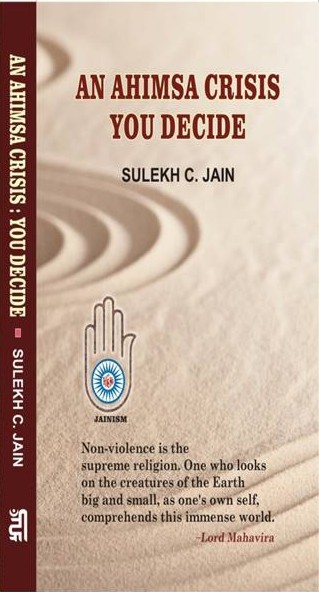In Jainism, ahimsa is the basis for the fundamental right of the existence of all life forms (jiva). According to Jainism, we must each remember, “I am a soul, not a body. I am eternal, constant and pure. All around me in this universe (irrespective of what life form/shapeone is), every single living being, big and small, human and non-human, plant and organism, has a soul just like me. All souls are eternal. Each soul is independent and individual. All souls are spiritually equal to one another. Each soul has the same inherent attributes of infinite knowledge, infinite perception and infinite consciousness. All souls want to live in peace and happiness. Each soul has the same feelings for happiness and suffering. No soul wants or desires suffering.
All souls have the same rights to live peacefully and undisturbed as I do. Since all souls are just like me and have the same rights and privileges as I do, I have no right to harm, kill, torture, disturb or interfere in any way in the life and existence of another soul.”
This respect for the equality of every single living thing forms the basis of ahimsa. Because ahimsa is the highest attribute and the greatest religion, the Jainism’s most fundamental motto is “live and help others to live.”
Jains envision the broad and all-encompassing definition of ahimsa as follows:
“Mentally, verbally, physically,
Directly, indirectly, knowingly, unknowingly,
Intentionally, and unconditionally,
Not by self, not through others (engage or ask others) and
Not condone or provide support to others in any shape or form
To injure, harm, abuse, oppress, enslave, insult, discriminate, torment,
persecute, torture or kill,
Any creature or living being (humans and non-humans) however so small,
Is nonviolence (ahimsa).”
In addition to this all-encompassing definition of ahimsa, there are many others. For example, these include: “[the] non- severance of vitalities (pranas) of self or others is Ahimsa.” Similarly, compassion (karuna) is defined as “developing fellow feelings or distress at the suffering of other living beings.” In other words, to consider another’s suffering as your own is compassion.
Ahimsa has many connotations. When we say “ahimsa,” we generally think of not killing or not hurting others through words or actions. But this is perhaps only ten percent of the fullness of ahimsa. Like a glacier, most of its meaning is initially hidden.
When seeking to define ahimsa, Tulsi, a Jain Acharya and 20th century social reformer, described three conditions that must be met, Tulsi exhorts;
“First, do not kill or hurt any living being, mentally, verbally or by actions, even to the extent of not inspiring others who commit himsa. Second, extend equanimity towards all living beings. Positive values such as respect, love, kindness, and compassion towards all are included in this. Third, be vigilant.” The first two occur when another being is involved. The third is internal. Whatever the time of the day, whether living in solitude or in a group, whether asleep or awake, there must be self-awareness. Whatever we do, we should do knowingly, said Acharya Tulsi. All our actions, our words, and our emotions should be positive; this is ahimsa.
The first condition is a “do not.” The other two conditions are “do” commands. A combination of all three is a complete definition of ahimsa, or nonviolence. Being an ahimsak (non-violent) is symbolized by inner harmony and is an accomplishment in itself. All other triumphs will naturally follow.
The definition and necessity of ahimsa is absolute, universal, unconditional, and eternal. There are no loopholes. The definition of ahimsa is not subject to different interpretations to suit the convenience and circumstances of a practitioner.
Professor Padmanabh Jaini calls ahimsa the “central concept of Jaina ethics.”[7] While all Indian philosophical schools attach great importance to this concept, “none has carried it to the extreme of the Jainas. For them it is not simply the first among virtues but the virtue; all other restraints are simply elaborations of this central one.” By practicing ahimsa, Jains hope to avoid both deliberate as well as accidental injury to all other living beings. The practice of ahimsa is the first step, but Jains also hope that attitudinal changes will accompany practice. A practitioner hopes to reach a state of consciousness where he realizes that he is not his possessions, his body, or even his mental states. Moreover, a new awareness of “a strong feeling of identification with all [living] beings” and the realization that “every living being possesses a soul that may be capable of attaining omniscience” accompany practice as well. In turn, “this awareness of the basic worth of all beings, and of one’s kinship with them, generates a feeling of great compassion…for others.” Jains, then, begin with a desire to end their perpetual rebirth into suffering bodies, and arrive at a place of deep compassion for all living things through attitudinal changes that accompany the practice of ahimsa.
Professor Gary Francione says, “I consider the principle of ahimsa to be the principle of democracy of existence of all life forms. In my opinion, anekanatavada - the Jain principle that no single point of view affords the complete truth - does not give us the freedom to choose a different interpretation of ahimsa. Ahimsa has only one meaning.”
According to Jainism, ahimsa is every person’s dharma (duty). It is to be practiced all the time with all the energies of the practitioner. It is not for sermons and preaching. It is for practice.
Having understood the basis and the definition of ahimsa, now we turn our attention to the types, classification, and intensity of himsa, and to how ahimsa is committed and practiced.
 Dr. Sulekh Chand Jain
Dr. Sulekh Chand Jain
